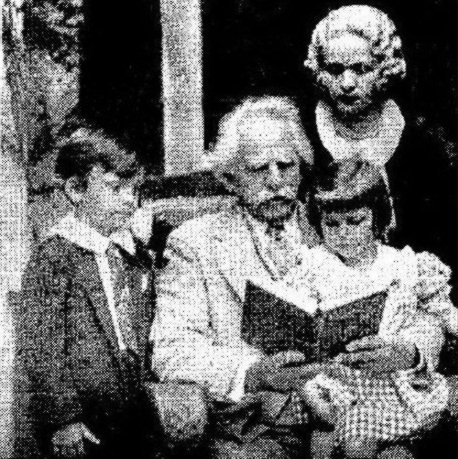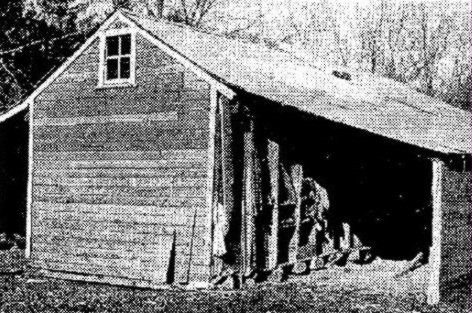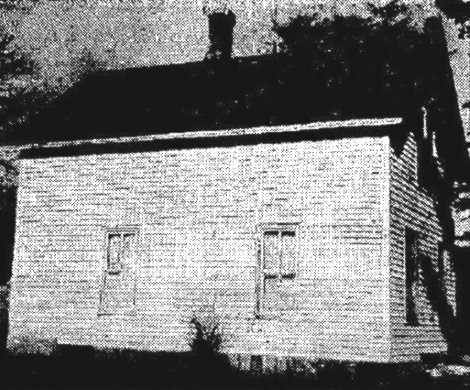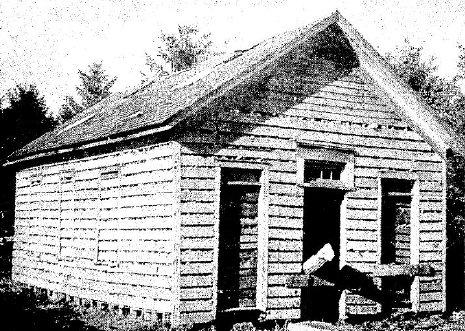|
MASON CITY GLOBE-GAZETTE STORY ON HAMLIN GARLAND, NOV. 23, 1956
Hamlin Garland's Boyhood Home-- Osage Has Forgotten Author By Bill Webb OSAGE -- Hamlin Garland's ghost was worn thin in this North Iowa community. Few Remember him and there are some who never have heard of him. Yet the famed Iowa author lived in Osage and Mitchell County as a boy from 1870 to 1881. The farm house northeast of here in which he lived has been remodeled and the country school he attended now is a corn crib. In Osage, the Cedar Valley Seminary from which he was graduated in 1881 now is a grade school and the home the Garland family moved into from the farm is no longer in existence.
Somewhere in Osage is a door to the grain elevator where Hamlin assisted his father. His father managhed the elevator for the local Grange at one time. The elevator is gone, but the door supposedly was saved. On it young Garland had scrawled his name in white paint. The door was last in the possession of Maurice Kathan, Osage mail carrier, whose grandfather bought the elevator from the Grange after the Garlands went back to farming. Kathan recalls that the painted name was faint when the door was loaned to the D.A.R. in 1931 during the town's diamond jubilee. He cannot remember of having seen it since. The occasion of the loan was the unveiling of a plaque honoring Garland by the late Judge Alva B. Lovejoy, Waterloo. The plaque is bolted to the white stucco front of the old seminary building. It reads: "Hamlin Garland as a student here (1876-1881) received his first literary inspiration and from this environment came much of the material for his early fiction, his poems and Middle Border chonicle." The plaque marks the only visible evidence of Garland's life in the community. Otherwise there is no trace of the Garland family except the stone on the grave of Hamlin's older sister, Harriet, in the Osage Cemetery. She died of typhoid pneumonia May 5, 1875, according to courthouse records. She was 17 years old. Garland may have lived to become the dean of American literature, but in Osage he is remembered as being an eccentric youth. Frank Jacobs, whose brother attended country school with him, said, "Hamlin always was kind of tony. He always was wearing kid gloves when working." Jacobs recalls that his brother, Charles, once saw young Garland plowing in a white frock coat. "How he hated farm work," he said. "and even more than dirt." Grace Bush Gardner said, "Hamlin had a superiority complex." Mrs. Gardner is the daughter of the Rev. Alva Bush, who founded the Cedar Valley Seminary in 1961 and was principal of the school until 1881. The Baptist school was closed in 1922. Others remember him as being bashful or indifferent. None, however, seem to have been particularly impressed by him.
Whatever it was, Garland wasn't indifferent, for his early books, "Main-Travelled Roads" (1891), "Prairie Folks" (1893) and "Other Main-Travelled Roads" (1910), remain among the most bitter indictments of the farm in American fiction. They picture the everyday life of the Iowa pioneers in the light of the hardships, the sweat, the barnyard smells, the dust, mud and grime, the endless routine of farm chores and the ugliness and inconvenience of the farm houses of the day. "I hate a cow!" Garland once said with feeling, and the "cinnamon hog" was an anathema to him. It was no wonder that yong Garland hated farming. From the age of 10, he was called upon to do a man's work in the field. But in later years, when the memories of his youth had faded, Garland mellowed and even became nostalgic in his treatment of farm life. By the time he wrote "A Son of the Middle Border" (1917), he was lavish in his descriptions of the prairie. Garland was one of the first "dirt farmer novelists" and the first American to write about the Midwest and "sell whta he wrote." In reviewing Iowa's literary history, Wallace Stegner saw Garland "as a man of the gifted Midwestern group that gathered in Chicago and as a forerunner of the many writers who now profess cultural regionalism as a literary creed." Some critics, however, had brickbats instead of bouguets for the Iowan's books. The late H.L. Mencken said the "case of Hamlin Garland belongs to the pathos in the grand manner, as ". . . discovered . . ." on reading his autobiography, 'A Son of the Middle Border.'" "It is in substance, a document of considerable value--naive and often a highly illuminating contribution to the history of American peasantry. It is, in form, a thoroughly third-rate piece of writing--amateurish, flat, banal, repellent." Garland was born at West Salem, Wisconsin, September 14, 1860. He was the second of four children. In 1869, five years after his father's return from the Civil War, the Garlands moved to a little farm two miles west of the Quaker village of Hesper in Winneshiek county, Iowa. The family moved all of its belongings by sleigh. "This farm . . . immediately won out love," Garland said. "It was a glorious place for boys. Broad-armed white oaks stood about the yard, and to the east and north a deep forest invited to exploration. The house was of logs and for that reason was much more attractive to us than to our mother. It was I suspect, both dark and cold. I know the roof was poor, for one morning I awoke to find a miniature peak of snow on the floor at my bedside."
The next spring, Garland's father sold the farm to an Englishman and purchased a quarter section in Mitchell County. Late in August 1870 the family loaded its household goods into wagons and with a small heard of cattle following, set out toward the west. "On the afternoon of the second day," Garland said, "we came to the meadow so wide that its western rim touched the sky without revealing a sign of man's habitation other than the road in which we travelled." That night the Garland's arrived on a rented farm a mile north of the quarter section where they were to stay while buildings were erected on their land. "The cabin faced a level plain with no tree in sight. A mile away to the west stood a low stone house and immediately in from of us opened a hald-section of unfenced sod. To the north, as far as I could see, the land billowed like a russet ocean, with scarcely a roof to fleck its lonely spread." A neighbor, Osmond Button, helped Hamlin's father re-enforce the cabin which actually was no more than a shell of pine boards. The Buttons became good friends of the Garlands. Hamlin often played with the young Button children, Eva and Cyrus, and sometimes was involved in activities with the older ones, Albert and Lavinia. Most of the Button family is buried in the Osage cemetery not farm from the grave of Hamlin's sister. Osmond died in 1910 at the age of 89. Albert, who was born in 1851, lived until 1934. Eva died in 1945. She was born in 1859. The schoolhouse which Garland attended stood on the bare prairie about a mile to the southwest on the northeast corner of his father's quarter section. It was painted a glaring white on the outside and a desolate "drab" within. "At least drab was the original color, but the benches were mainly so greasy and hacked that original intentions were obscured. It had two doors on the eastern end and three windows on each side. "A long square stove (standing on slender legs in a puttle of bricks), a wooden chair, and a rude table in one corner, for the use of the teacher, completed the movable furniture. The walls were roughly plastered and the windows had no curtains . . . . There was not a leaf to shade it in summer nor a branch to break the winds of savage winter." The school building later was made into a chicken house. It now is a corn crib on the nearby Harold Swan farm. The new Garland house on the quarter section was built by Hanlin's father as were the sheds, granary and corn cribs. The house was small with only a kitchen and parlor downstairs and the bedrooms in the attic which was reached by a ladder up the outside of the building and through a window. Garland's father stacked bricks between the uprights to hold the building against the strong winter winds on the treeless prairie. Rough boards were nailed to the uprights on either side to form the walls of the house. Theinterior walls in the attic were papered with newspaper. The downstairs was plastered. It was the only heated part of the house. When the family moved from Osage to the Dakotas in 1881, the farm was sold to Robert McClean, who like the Garlands had came west by way of Wisconsin. The farm which is located 2 1/2 miles northeast of Osage now is operated by McClean's grandson, Lyle Loney. The house has been remodeled and added to many times since it was occupied by the Garland family. It was in the spring of 1875 that the Garland family moved into town. Their house was located in Osage at about where the Ray Peterson now live at 421 Walnut. The next year young Garland entered the Cedar Valley Seminary.
"The school wasd in truth a very primitive institution," according to Garland, "hardly more than a high school, but it served its purpose." After a short period of teaching school in Illinois, Garland took up a claim in McPherson County, N.D. in 1883, but the next year he mortgaged it for $200 and went to Boston, wearing a queer Gopher-prairie outfit of store clothes, to embark on a career of letters. He lived in bleak little attic rooms, "breakfasted on eight cents, dines on 15 and supped on 10; wore his prairie born coat to a shine and his cuffs to a frazzle and was shrunken thin by low fare." His first literary contributions of "consequence" was a story on corn husking which he sold to "Harpers Magazine for $25. He was electred to the American Academy of Arts and Letters in 1918. In 1922, he won a Pulitzer prize for "A Daughter of the Middle Border." Garland died March 4, 1940, of a cerebral hemorrhage at his Hollywood Hills, California home. He was finishing the last chapter of a book when he was stricken. The book on SOuthern California was to be called "Fortunate Exile." Garland returned to Osage only twice after 1881. In 1886, he came back to reacquaint himself with the environment of his boyhood. He gathered the material for his autobiography which he was to write 20 years later. He lectured to a meager audience in 1897 on his experiences in the Klondike. With him was Burton Babcock, an Osage boyhood companion, who had accompanied him to Alaska. |
Webization by Kermit Kittleson, July 2009



